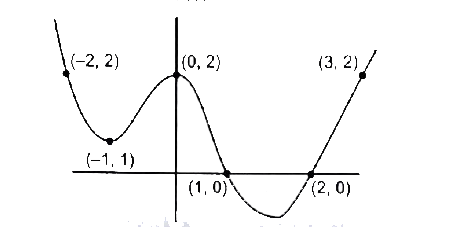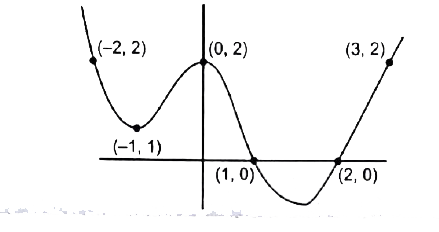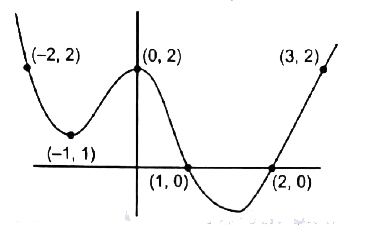In the given figure graph of :
y=p(x)=xn+a1xn−1+a2xn−2+…..+an is given.

The product of all imaginary roots of p(x)=0 is:
1
2
3
4
The correct Answer is:D
Step by step video & image solution for In the given figure graph of : y =p (x) = x ^(n)+a_(1) x ^(n-1) +a_(2) x ^(n-2)+ ….. + a _(n) is given. The product of all imaginary roots of p(x) =0 is: by Maths experts to help you in doubts & scoring excellent marks in Class 10 exams.
Updated on:21/07/2023Topper's Solved these Questions
- SAMPLE PAPER 02Book:EDUCART PUBLICATIONChapter:SAMPLE PAPER 02Exercise:SECTION - A
Explore 11 Videos
- SAMPLE PAPER 02Book:EDUCART PUBLICATIONChapter:SAMPLE PAPER 02Exercise:SECTION - A Fill in the blanks
Explore 6 Videos
- SAMPLE PAPER 02Book:EDUCART PUBLICATIONChapter:SAMPLE PAPER 02Exercise:SECTION-B
Explore 20 Videos
- SAMPLE PAPER 01Book:EDUCART PUBLICATIONChapter:SAMPLE PAPER 01Exercise:PART-B (SECTION-V)
Explore 4 Videos
- SAMPLE PAPER 03Book:EDUCART PUBLICATIONChapter:SAMPLE PAPER 03Exercise:Section - C
Explore 10 Videos
Similar Questions
In the given figure graph of :
y=p(x)=xn+a1xn−1+a2xn−2+…..+an is given.

The minimum number of real roots of equation (p'(x))2+p(x)p''(x)=0 are:
View SolutionIn the given figure graph of :
y=p(x)=xn+a1xn−1+a2xn−2+…..+an is given.

If p(x)+k=0 has 4 distinct real roots α,β,γ,δ then[α]+[β]+[γ]+[δ], (where [.] denotes greatest integer function) is equal to:
View Solution
Knowledge Check
If (1+x+x2+x3)n=a0+a1x+a2x2+………..a3nx3n then which of following are correct
Aa0+a1+a2+……+a3n=22nBa0+a2+a4+……=a1+a3+a5+……..Ca0=a3n,a1=a3n−1,a2=a3n−2Da0+a2+a4+…….=22n−1Let (1+x2)2(1+x)n=a0+a1x+a2x2+… if
a1,a2 and a3 are in A.P , the value of n isA2B3C4D7
Differentiate |x|+a0xn+a1xn−1+a2xn−1+...+an−1x+an
View SolutionDifferentiate the following with respect of x:a0xn+a1xn−1+a2xn−2++an−1x+an.
View Solution(1+x)n=a0+a1x+a2⋅x2+.........+anxn then prove that
View SolutionLet f(x)=a0xn+a1xn−1+a2xn−2+.......+an,(a0≠0) if a0+a1+a+2+......+an=0 then the root of f(x) is
View Solutiona0fn(x)+a1fn−1(x).g(x)+a2fn−2g2(x)+......+angn(x)≥0
View SolutionLet f(x)=a0xn+a1xn−1+a2xn−2+….+an−1x+an, where a0,a1,a2,....,an are real numbers. If f(x) is divided by (ax - b), then the remainder is
View Solution